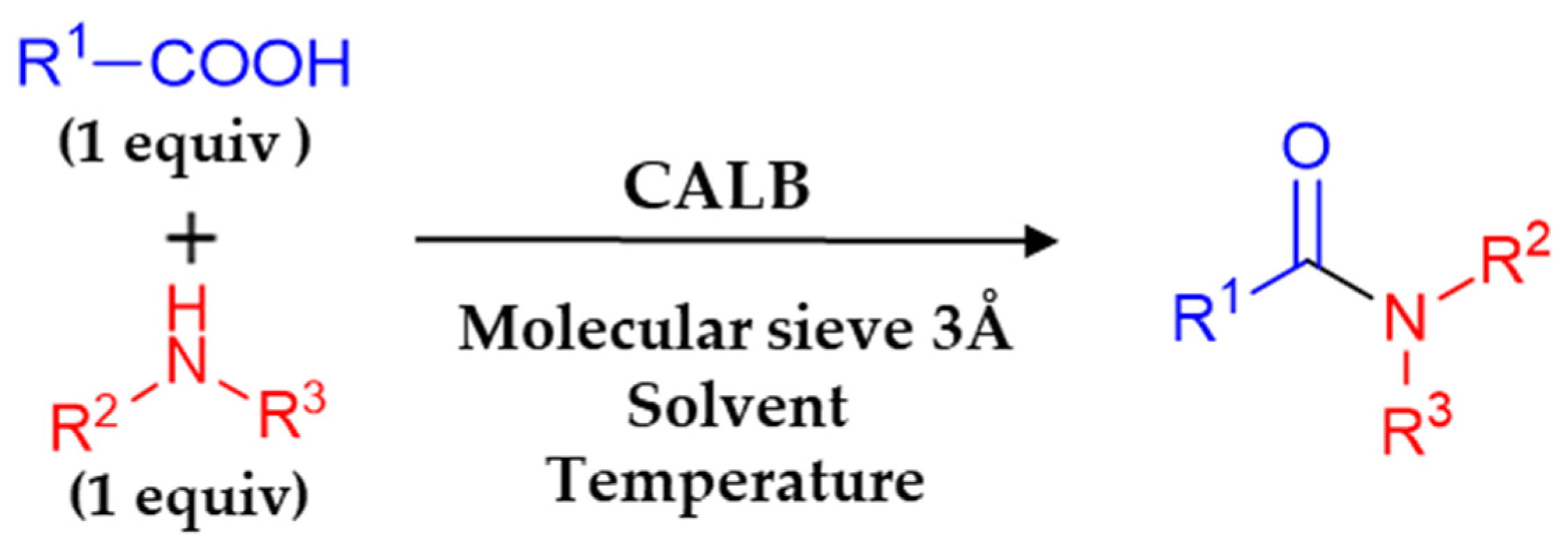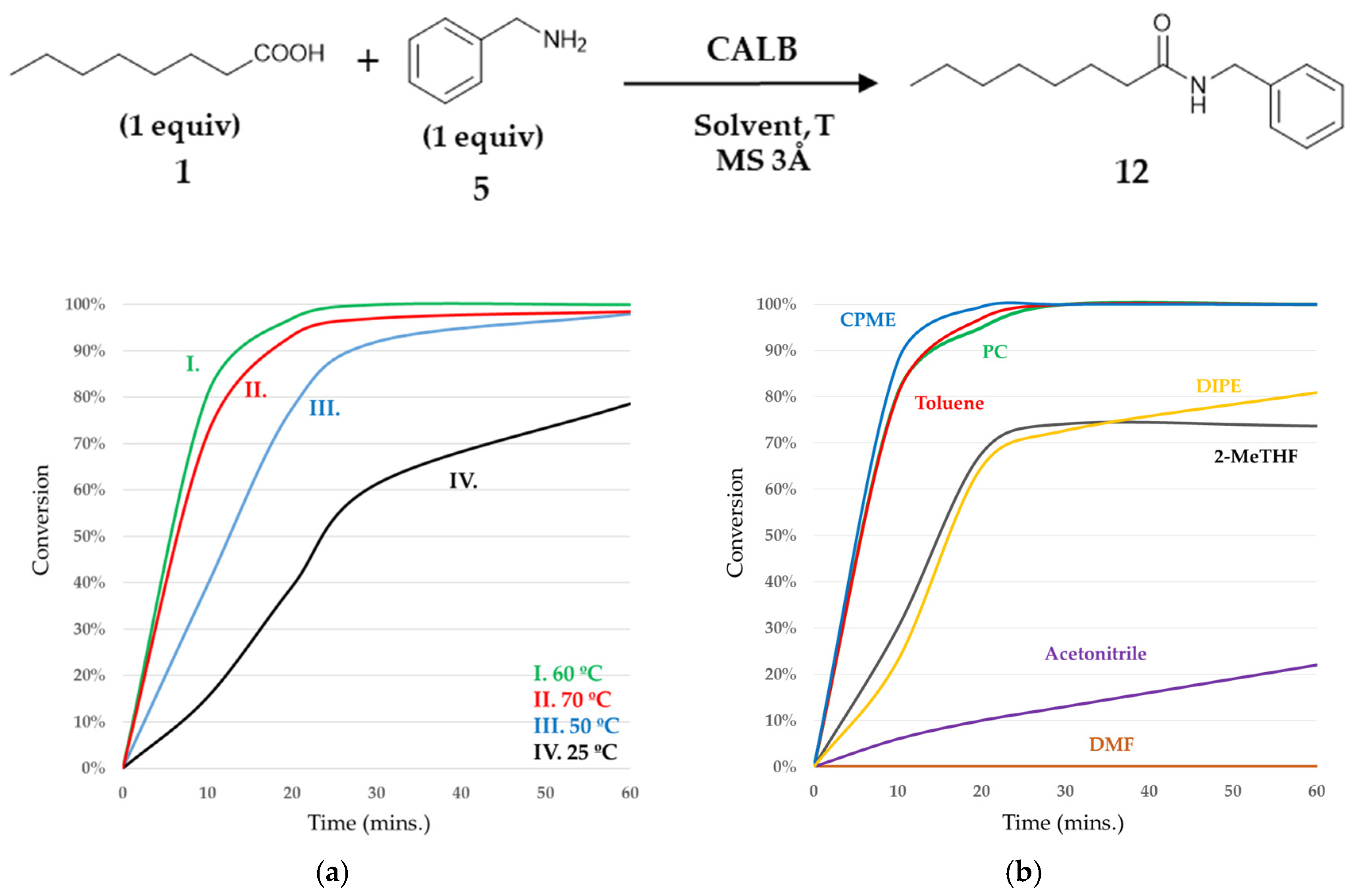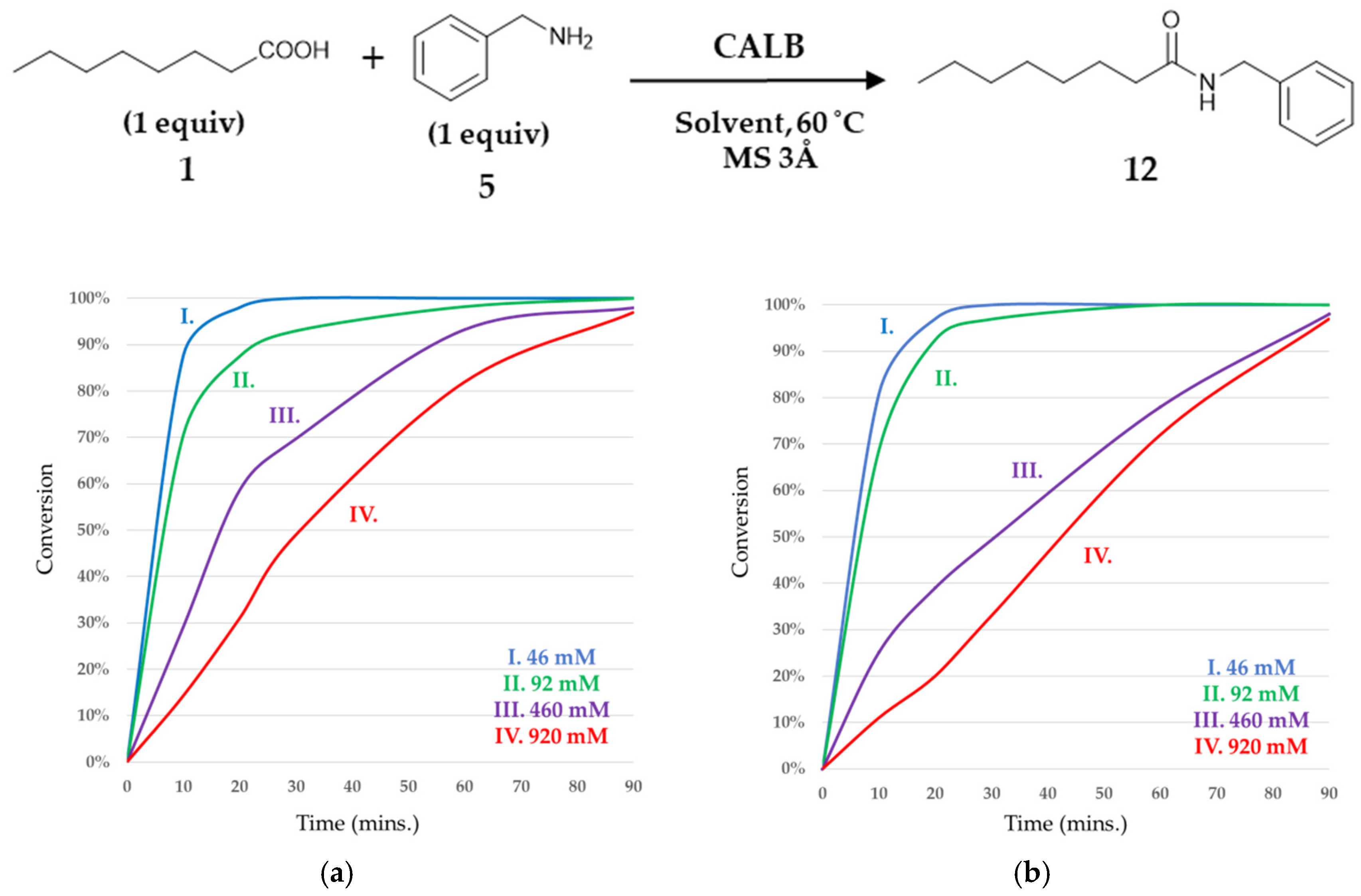A Sustainable Green Enzymatic Method for Amide Bond Formation
Abstract
1. Introduction
2. Results and Discussion
3. Materials and Methods
3.1. General
3.2. General Procedure for CALB-Catalyzed Amidation
3.2.1. N-Benzyloctanamide (12)
3.2.2. N-Benzylhexanamide (13)
3.2.3. N-Enzylbutyramide (14)
3.2.4. N-Benzyl-4-phenylbutanamide (15)
3.2.5. N-Allyloctanamide (16)
3.2.6. N-Allylhexanamide (17)
3.2.7. N-Allylbutyramide (18)
3.2.8. N-Allyl-4-phenylbutanamide (19)
3.2.9. N-(Prop-2-yn-1-yl)octanamide (20)
3.2.10. N-(Prop-2-yn-1-yl)hexanamide (21)
3.2.11. N-(Prop-2-yn-1-yl)butyramide (22)
3.2.12. 4-Phenyl-N-(prop-2-yn-1-yl)butanamide (23)
3.2.13. 1-(Piperidin-1-yl)octan-1-one (24)
3.2.14. 1-(Piperidin-1-yl)hexan-1-one (25)
3.2.15. 1-(Piperidin-1-yl)butan-1-one (26)
3.2.16. 4-Phenyl-1-(piperidin-1-yl)butan-1-one (27)
3.2.17. 1-Morpholinooctan-1-one (28)
3.2.18. 1-Morpholinohexan-1-one (29)
3.2.19. 1-Morpholinobutan-1-one (30)
3.2.20. 1-Morpholino-4-phenylbutan-1-one (31)
3.2.21. N-(2-(Dimethylamino)ethyl)octanamide (32)
3.2.22. N-(2-(Dimethylamino)ethyl)hexanamide (33)
3.2.23. N-(2-(Dimethylamino)ethyl)butyramide (34)
3.2.24. N-(2-(Dimethylamino)ethyl)-4-phenylbutanamide (35)
3.2.25. N-(3-(Dimethylamino)propyl)ctanamide (36)
3.2.26. N-(3-(Dimethylamino)propyl)hexanamide (37)
3.2.27. N-(3-(Dimethylamino)propyl)butyramide (38)
3.2.28. N-(3-(Dimethylamino)propyl)-4-phenylbutanamide (39)
4. Conclusions
Supplementary Materials
Author Contributions
Funding
Institutional Review Board Statement
Informed Consent Statement
Data Availability Statement
Conflicts of Interest
Sample Availability
References
- Mahesh, S.; Tang, K.-C.; Raj, M. Amide Bond Activation of Biological Molecules. Molecules 2018, 23, 2615. [Google Scholar] [CrossRef]
- Pattabiraman, V.R.; Bode, J.W. Rethinking amide bond synthesis. Nature 2011, 480, 471–479. [Google Scholar] [CrossRef]
- Wieland, T.; Bodanszky, M. The World of Peptides: A Brief History of Peptide Chemistry; Springer: Berlin/Heidelberg, Germany, 2012; pp. 1–22. ISBN 978-3-642-75850-8. [Google Scholar]
- Ohashi, N.; Kohno, T. Analgesic Effect of Acetaminophen: A Review of Known and Novel Mechanisms of Action. Front. Pharmacol. 2020, 11, 580289. [Google Scholar] [CrossRef]
- Day, T.K.; Skarda, R.T. The pharmacology of local anesthetics. Vet. Clin. N. Am. Large Anim. Pract. 1991, 7, 489–500. [Google Scholar] [CrossRef] [PubMed]
- Becker, D.E.; Reed, K.L. Local anesthetics: Review of pharmacological considerations. Anesth. Prog. 2012, 59, 90–102. [Google Scholar] [CrossRef] [PubMed]
- Lima, L.M.; Silva, B.; Barbosa, G.; Barreiro, E.J. β-lactam antibiotics: An overview from a medicinal chemistry perspective. Eur. J. Med. Chem. 2020, 208, 112829. [Google Scholar] [CrossRef]
- Turner, J.; Muraoka, A.; Bedenbaugh, M.; Childress, B.; Pernot, L.; Wiencek, M.; Peterson, Y.K. The Chemical Relationship Among Beta-Lactam Antibiotics and Potential Impacts on Reactivity and Decomposition. Front. Microbiol. 2022, 13, 807955. [Google Scholar] [CrossRef]
- King, D.T.; Sobhanifar, S.; Strynadka, N.C.J. One ring to rule them all: Current trends in combating bacterial resistance to the β-lactams. Protein Sci. 2016, 25, 787–803. [Google Scholar] [CrossRef]
- Saxena, P.; Sharma, P.K.; Purohit, P. A journey of celecoxib from pain to cancer. Prostaglandins Other Lipid Mediat. 2020, 147, 106379. [Google Scholar] [CrossRef]
- Sadée, W.; Bohn, L. How specific are “target-specific” drugs? Celecoxib as a case in point. Mol. Interv. 2006, 6, 196–198. [Google Scholar] [CrossRef]
- Bering, L.; Craven, E.J.; Sowerby Thomas, S.A.; Shepherd, S.A.; Micklefield, J. Merging enzymes with chemocatalysis for amide bond synthesis. Nat. Commun. 2022, 13, 380. [Google Scholar] [CrossRef]
- Allen, C.L.; Williams, J.M.J. Metal-catalysed approaches to amide bond formation. Chem. Soc. Rev. 2011, 40, 3405–3415. [Google Scholar] [CrossRef]
- Massolo, E.; Pirola, M.; Benaglia, M. Amide Bond Formation Strategies: Latest Advances on a Dateless Transformation. Eur. J. Org. Chem. 2020, 2020, 4641–4651. [Google Scholar] [CrossRef]
- Todorovic, M.; Perrin, D.M. Recent developments in catalytic amide bond formation. Pept. Sci. 2020, 112, e24210. [Google Scholar] [CrossRef]
- El-Faham, A.; Albericio, F. Peptide Coupling Reagents, More than a Letter Soup. Chem. Rev. 2011, 111, 6557–6602. [Google Scholar] [CrossRef]
- Valeur, E.; Bradley, M. Amide bond formation: Beyond the myth of coupling reagents. Chem. Soc. Rev. 2009, 38, 606–631. [Google Scholar] [CrossRef] [PubMed]
- Orsy, G.; Fülöp, F.; Mándity, I.M. Direct amide formation in a continuous-flow system mediated by carbon disulfide. Catal. Sci. Technol. 2020, 10, 7814–7818. [Google Scholar] [CrossRef]
- Lundberg, H.; Tinnis, F.; Selander, N.; Adolfsson, H. Catalytic amide formation from non-activated carboxylic acids and amines. Chem. Soc. Rev. 2014, 43, 2714–2742. [Google Scholar] [CrossRef]
- Hazra, S.; Gallou, F.; Handa, S. Water: An Underestimated Solvent for Amide Bond-Forming Reactions. ACS Sustain. Chem. Eng. 2022, 10, 5299–5306. [Google Scholar] [CrossRef]
- Sabatini, M.T.; Boulton, L.T.; Sneddon, H.F.; Sheppard, T.D. A green chemistry perspective on catalytic amide bond formation. Nat. Catal. 2019, 2, 10–17. [Google Scholar] [CrossRef]
- Zhang, R.; Yao, W.-Z.; Qian, L.; Sang, W.; Yuan, Y.; Du, M.-C.; Cheng, H.; Chen, C.; Qin, X. A practical and sustainable protocol for direct amidation of unactivated esters under transition-metal-free and solvent-free conditions. Green Chem. 2021, 23, 3972–3982. [Google Scholar] [CrossRef]
- Dunetz, J.R.; Magano, J.; Weisenburger, G.A. Large-Scale Applications of Amide Coupling Reagents for the Synthesis of Pharmaceuticals. Org. Process Res. Dev. 2016, 20, 140–177. [Google Scholar] [CrossRef]
- Magano, J. Large-Scale Amidations in Process Chemistry: Practical Considerations for Reagent Selection and Reaction Execution Organic. Org. Process Res. Dev. 2022, 26, 1562–1689. [Google Scholar] [CrossRef]
- Ganesh, K.N.; Zhang, D.; Miller, S.J.; Rossen, K.; Chirik, P.J.; Kozlowski, M.C.; Zimmerman, J.B.; Brooks, B.W.; Savage, P.E.; Allen, D.T.; et al. Green Chemistry: A Framework for a Sustainable Future. Org. Process Res. Dev. 2021, 25, 1455–1459. [Google Scholar] [CrossRef]
- Anastas, P.; Eghbali, N. Green Chemistry: Principles and Practice. Chem. Soc. Rev. 2010, 39, 301–312. [Google Scholar] [CrossRef]
- Meyer, H.-P.; Eichhorn, E.; Hanlon, S.; Lütz, S.; Schürmann, M.; Wohlgemuth, R.; Coppolecchia, R. The use of enzymes in organic synthesis and the life sciences: Perspectives from the Swiss Industrial Biocatalysis Consortium (SIBC). Catal. Sci. Technol. 2013, 3, 29–40. [Google Scholar] [CrossRef]
- Silverman, R.B. Organic Chemistry of Enzyme-Catalyzed Reactions, 2nd ed.; Academic Press: San Diego, SD, USA, 2002; pp. 1–38. ISBN 978-0-08-051336-2. [Google Scholar]
- Strohmeier, G.A.; Pichler, H.; May, O.; Gruber-Khadjawi, M. Application of Designed Enzymes in Organic Synthesis. Chem. Rev. 2011, 111, 4141–4164. [Google Scholar] [CrossRef]
- Winkler, C.K.; Schrittwieser, J.H.; Kroutil, W. Power of Biocatalysis for Organic Synthesis. ACS Cent. Sci. 2021, 7, 55–71. [Google Scholar] [CrossRef]
- Forró, E.; Fülöp, F. Advanced procedure for the enzymatic ring opening of unsaturated alicyclic β-lactams. Tetrahedron Asymmetry 2004, 15, 2875–2880. [Google Scholar] [CrossRef]
- Shoda, S.-i.; Uyama, H.; Kadokawa, J.-i.; Kimura, S.; Kobayashi, S. Enzymes as Green Catalysts for Precision Macromolecular Synthesis. Chem. Rev. 2016, 116, 2307–2413. [Google Scholar] [CrossRef]
- Sheldon, R.A. Engineering a more sustainable world through catalysis and green chemistry. J. R. Soc. Interface 2016, 13, 20160087. [Google Scholar] [CrossRef] [PubMed]
- Augustin, M.M.; Augustin, J.M.; Brock, J.R.; Kutchan, T.M. Enzyme morphinan N-demethylase for more sustainable opiate processing. Nat. Sustain. 2019, 2, 465–474. [Google Scholar] [CrossRef]
- Sheldon, R.A.; Brady, D. Green Chemistry, Biocatalysis, and the Chemical Industry of the Future. ChemSusChem 2022, 15, e202102628. [Google Scholar] [CrossRef] [PubMed]
- Stergiou, P.Y.; Foukis, A.; Filippou, M.; Koukouritaki, M.; Parapouli, M.; Theodorou, L.G.; Hatziloukas, E.; Afendra, A.; Pandey, A.; Papamichael, E.M. Advances in lipase-catalyzed esterification reactions. Biotechnol. Adv. 2013, 31, 1846–1859. [Google Scholar] [CrossRef] [PubMed]
- Gamayurova, V.S.; Zinov’eva, M.E.; Shnaider, K.L.; Davletshina, G.A. Lipases in Esterification Reactions: A Review. Catal. Ind. 2021, 13, 58–72. [Google Scholar] [CrossRef]
- Singhania, V.; Cortes-Clerget, M.; Dussart-Gautheret, J.; Akkachairin, B.; Yu, J.; Akporji, N.; Gallou, F.; Lipshutz, B.H. Lipase-catalyzed esterification in water enabled by nanomicelles. Applications to 1-pot multi-step sequences. Chem. Sci. 2022, 13, 1440–1445. [Google Scholar] [CrossRef]
- Kumar, A.; Dhar, K.; Kanwar, S.S.; Arora, P.K. Lipase catalysis in organic solvents: Advantages and applications. Biol. Proced. Online 2016, 18, 2. [Google Scholar] [CrossRef] [PubMed]
- Ingenbosch, K.N.; Vieyto-Nuñez, J.C.; Ruiz-Blanco, Y.B.; Mayer, C.; Hoffmann-Jacobsen, K.; Sanchez-Garcia, E. Effect of Organic Solvents on the Structure and Activity of a Minimal Lipase. J. Org. Chem. 2022, 87, 1669–1678. [Google Scholar] [CrossRef]
- Ortiz, C.; Ferreira, M.L.; Barbosa, O.; dos Santos, J.C.S.; Rodrigues, R.C.; Berenguer-Murcia, Á.; Briand, L.E.; Fernandez-Lafuente, R. Novozym 435: The “perfect” lipase immobilized biocatalyst? Catal. Sci. Technol. 2019, 9, 2380–2420. [Google Scholar] [CrossRef]
- Mangiagalli, M.; Carvalho, H.; Natalello, A.; Ferrario, V.; Pennati, M.L.; Barbiroli, A.; Lotti, M.; Pleiss, J.; Brocca, S. Diverse effects of aqueous polar co-solvents on Candida antarctica lipase B. Int. J. Biol. Macromol. 2020, 150, 930–940. [Google Scholar] [CrossRef]
- Zieniuk, B.; Fabiszewska, A.; Białecka-Florjańczyk, E. Screening of solvents for favoring hydrolytic activity of Candida antarctica Lipase B. Bioprocess Biosyst. Eng. 2020, 43, 605–613. [Google Scholar] [CrossRef] [PubMed]
- Forró, E.; Fülöp, F. Enzymatic Strategies for the Preparation of Pharmaceutically Important Amino Acids through Hydrolysis of Amino Carboxylic Esters and Lactams. Curr. Med. Chem. 2022, 29, 6218–6227. [Google Scholar] [CrossRef] [PubMed]
- Megyesi, R.; Forró, E.; Fülöp, F. Substrate engineering: Effects of different N-protecting groups in the CAL-B-catalysed asymmetric O-acylation of 1-hydroxymethyl-tetrahydro-β-carbolines. Tetrahedron 2018, 74, 2634–2640. [Google Scholar] [CrossRef]
- Shahmohammadi, S.; Faragó, T.; Palkó, M.; Forró, E. Green Strategies for the Preparation of Enantiomeric 5–8-Membered Carbocyclic β-Amino Acid Derivatives through CALB-Catalyzed Hydrolysis. Molecules 2022, 27, 2600. [Google Scholar] [CrossRef]
- Sun, M.; Nie, K.; Wang, F.; Deng, L. Optimization of the Lipase-Catalyzed Selective Amidation of Phenylglycinol. Front. Bioeng. Biotechnol. 2020, 7, 486. [Google Scholar] [CrossRef]
- Pitzer, J.; Steiner, K.; Schmid, C.; Schein, V.K.; Prause, C.; Kniely, C.; Reif, M.; Geier, M.; Pietrich, E.; Reiter, T.; et al. Racemization-free and scalable amidation of l-proline in organic media using ammonia and a biocatalyst only. Green Chem. 2022, 24, 5171–5180. [Google Scholar] [CrossRef]
- Hassan, S.; Tschersich, R.; Müller, T.J.J. Three-component chemoenzymatic synthesis of amide ligated 1,2,3-triazoles. Tetrahedron Lett. 2013, 54, 4641–4644. [Google Scholar] [CrossRef]
- Irimescu, R.; Kato, K. Lipase-catalyzed enantioselective reaction of amines with carboxylic acids under reduced pressure in non-solvent system and in ionic liquids. Tetrahedron Lett. 2004, 45, 523–525. [Google Scholar] [CrossRef]
- Prasad, A.K.; Husain, M.; Singh, B.K.; Gupta, R.K.; Manchanda, V.K.; Olsen, C.E.; Parmar, V.S. Solvent-free biocatalytic amidation of carboxylic acids. Tetrahedron Lett. 2005, 46, 4511–4514. [Google Scholar] [CrossRef]
- Gotor, V. Non-conventional hydrolase chemistry: Amide and carbamate bond formation catalyzed by lipases. Bioorg. Med. Chem. 1999, 7, 2189–2197. [Google Scholar] [CrossRef]
- Manova, D.; Gallier, F.; Tak-Tak, L.; Yotava, L.; Lubin-Germain, N. Lipase-catalyzed amidation of carboxylic acid and amines. Tetrahedron Lett. 2018, 59, 2086–2090. [Google Scholar] [CrossRef]
- Dorr, B.M.; Fuerst, D.E. Enzymatic amidation for industrial applications. Curr. Opin. Chem. Biol. 2018, 43, 127–133. [Google Scholar] [CrossRef] [PubMed]
- Lima, R.N.; dos Anjos, C.S.; Orozco, E.V.M.; Porto, A.L.M. Versatility of Candida antarctica lipase in the amide bond formation applied in organic synthesis and biotechnological processes. Mol. Catal. 2019, 466, 75–105. [Google Scholar] [CrossRef]
- Lo, Y.C.; Lin, C.L.; Fang, W.Y.; Lőrinczi, B.; Szatmári, I.; Chang, W.H.; Fülöp, F.; Wu, S.N. Effective Activation by Kynurenic Acid and Its Aminoalkylated Derivatives on M-Type K+ Current. Int. J. Mol. Sci. 2021, 22, 1300. [Google Scholar] [CrossRef]
- Hollmann, F.; Kara, S.; Opperman, D.J.; Wang, Y. Biocatalytic synthesis of lactones and lactams. Chem.-Asian J. 2018, 13, 3601–3610. [Google Scholar] [CrossRef] [PubMed]
- Kunishima, M.; Watanabe, Y.; Terao, K.; Tani, S. Substrate-Specific Amidation of Carboxylic Acids in a Liquid-Liquid Two-Phase System Using Cyclodextrins as Inverse Phase-Transfer Catalysts. Eur. J. Org. Chem. 2004, 2004, 4535–4540. [Google Scholar] [CrossRef]
- Kim, S.E.; Hahm, H.; Kim, S.; Jang, W.; Jeon, B.; Kim, Y.; Kim, M. A Versatile Cobalt Catalyst for Secondary and Tertiary Amide Synthesis from Various Carboxylic Acid Derivatives. Asian J. Org. Chem. 2016, 5, 222–231. [Google Scholar] [CrossRef]
- Ojeda-Porras, A.; Hernandez-Santana, A.; Gamba-Sanchez, D. Direct amidation of carboxylic acids with amines under microwave irradiation using silica gel as a solid support. Green Chem. 2015, 17, 3157–3163. [Google Scholar] [CrossRef]
- Métro, T.-X.; Bonnamour, J.; Reidon, T.; Duprez, A.; Sarpoulet, J.; Martinez, J.; Lamaty, F. Comprehensive Study of the Organic Solvent-Free CDI-Mediated Acylation of Various Nucleophiles by Mechanochemistry. Chem. Eur. J. 2015, 21, 12787–12796. [Google Scholar] [CrossRef]
- Roe, E.T.; Stutzman, J.M.; Swern, D. Fatty Acid Amides. III.2a N-Alkenyl and N,N-Dialkenyl Amides2b. J. Am. Chem. Soc. 1951, 73, 3642–3643. [Google Scholar] [CrossRef]
- Willand, N.; Desroses, M.; Toto, P.; Dirié, B.; Lens, Z.; Villeret, V.; Rucktooa, P.; Locht, C.; Baulard, A.; Deprez, B. Exploring Drug Target Flexibility Using in Situ Click Chemistry: Application to a Mycobacterial Transcriptional Regulator. ACS Chem. Biol. 2010, 5, 1007–1013. [Google Scholar] [CrossRef] [PubMed]
- Tian, J.; Gao, W.-C.; Zhou, D.-M.; Zhang, C. Recyclable Hypervalent Iodine(III) Reagent Iodosodilactone as an Efficient Coupling Reagent for Direct Esterification, Amidation, and Peptide Coupling. Org. Lett. 2012, 14, 3020–3023. [Google Scholar] [CrossRef] [PubMed]
- Ouerghui, A.; Elamari, H.; Dardouri, M.; Ncib, S.; Meganem, F.; Girard, C. Chemical modifications of poly(vinyl chloride) to poly(vinyl azide) and “clicked” triazole bearing groups for application in metal cation extraction. Adv. Mater. Res. 2016, 100, 191–197. [Google Scholar] [CrossRef]
- Wei, W.; Hu, X.-Y.; Yan, X.-W.; Zhang, Q.; Cheng, M.; Ji, J.-X. Direct use of dioxygen as an oxygen source: Catalytic oxidative synthesis of amides. Chem. Commun. 2012, 48, 305–307. [Google Scholar] [CrossRef] [PubMed]
- Cromwell, N.H.; Creger, P.L.; Cook, K.E. Studies with the Amine Adducts of β-Benzoylacrylic Acid and its Methyl Ester. J. Am. Chem. Soc. 1956, 78, 4412–4416. [Google Scholar] [CrossRef]



 | ||||
|---|---|---|---|---|
| Substrates | Octanoic Acid (1) | Hexanoic Acid (2) | Butyric Acid (3) | 4-Phenylbutyric Acid (4) |
| benzylamine (5) |  12, 99% |  13, 98%, |  14, 98% |  15, 99% |
| allylamine (6) |  16, 96% |  17, 96% |  18, 94% |  19, 98% |
| propargylamine (7) |  20, 97% |  21, 98% |  22, 92% |  23, 97% |
| piperidine (8) |  24, 95% |  25, 93% |  26, 92% |  27, 97% |
| morpholine (9) |  28, 99% |  29, 98% |  30, 94% |  31, 96% |
| N1,N1-dimethylethane-1,2-diamine (10) |  32, 96% |  33, 98% |  34, 93% |  35, 97% |
| N1,N1-dimethylpropane-1,3-diamine (11) |  36, 99% |  37, 98% |  38, 92% |  39, 99% |
Disclaimer/Publisher’s Note: The statements, opinions and data contained in all publications are solely those of the individual author(s) and contributor(s) and not of MDPI and/or the editor(s). MDPI and/or the editor(s) disclaim responsibility for any injury to people or property resulting from any ideas, methods, instructions or products referred to in the content. |
© 2023 by the authors. Licensee MDPI, Basel, Switzerland. This article is an open access article distributed under the terms and conditions of the Creative Commons Attribution (CC BY) license (https://creativecommons.org/licenses/by/4.0/).
Share and Cite
Orsy, G.; Shahmohammadi, S.; Forró, E. A Sustainable Green Enzymatic Method for Amide Bond Formation. Molecules 2023, 28, 5706. https://doi.org/10.3390/molecules28155706
Orsy G, Shahmohammadi S, Forró E. A Sustainable Green Enzymatic Method for Amide Bond Formation. Molecules. 2023; 28(15):5706. https://doi.org/10.3390/molecules28155706
Chicago/Turabian StyleOrsy, György, Sayeh Shahmohammadi, and Enikő Forró. 2023. "A Sustainable Green Enzymatic Method for Amide Bond Formation" Molecules 28, no. 15: 5706. https://doi.org/10.3390/molecules28155706
APA StyleOrsy, G., Shahmohammadi, S., & Forró, E. (2023). A Sustainable Green Enzymatic Method for Amide Bond Formation. Molecules, 28(15), 5706. https://doi.org/10.3390/molecules28155706






